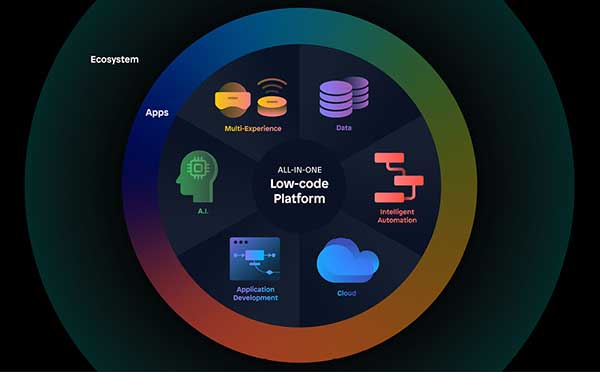Top Info On Picking application development with Low-code platforms
Top Info On Picking application development with Low-code platforms
Blog Article
Benefits Of Low-Code Application Development With Regard To Accessibility To Non-Developers
Low-code app development improves accessibility for non-developers (often referred to "citizen-developers") because of certain key aspects.
Drag-and–Drop Builders : Low-code platforms provide drag-and-drop interfaces that allow non-developers, without the necessity of writing code, to create visually-based applications. This makes development easier for those with no technical backgrounds.
WYSIWYG Editors WYSIWYG Editors "What You See Is What You Receive" editors aid users in creating workflows and interfaces that appear similar to the final product, making them more understandable.
Simple Logic and Workflow:
Visual Workflow Modeling: Users are able to create business processes and application logic through visual flowcharts and models, which are more intuitive than traditional coding methods.
Pre-built Logical Components: A lot of low-code platforms have already-built logic components (e.g. conditions, loops) and can be easily set up. This means that there is no requirement to write complex programs.
Reusable templates and components:
Library of pre-built templates Many low-code platforms offer a library of templates for common application types, enabling non-developers to start from a solid base and alter as required.
Reusable widgets and modules Utilizing modular or reusable widgets users can speed up the process of creating them by cutting down on the need for detailed technical know-how.
Guided Development and Tutorials
Step-by-step guides Platforms provide tutorials, on-screen tips, and guided development paths to assist developers who are not experts in developing applications.
Interactive Tutorials - Interactive tutorials that allow you to engage with the platform can aid in learning and increase confidence.
Integration of existing tools:
Seamless Integration: Low-code platforms are designed to seamlessly integrate with existing systems, tools, and software (e.g. ERP and CRM). This allows non-programmers with no experience in programming to create applications that are compatible with their existing workflows.
APIs Connectors: APIs are integrated into applications to make integration easier. This allows non-programmers, with no programming abilities, to connect to external services.
Collaboration Features:
Team Collaboration: Features, such as real-time collaboration as well as shared workspaces, allow non-developers and professionals to work together effectively.
Role-based Access Control: Non developers can be assigned specific roles and access levels. This enables them to contribute to development without compromising security or functionality.
Automated Testing and Debugging
Low-code platforms are often equipped with testing and debugging software that automates these processes. This makes it easier for non developers to verify their applications function correctly.
Error-highlighting: The platform points out problems and offers solutions to guide non-developers.
The general rule is that low-code application development has the ability to open up development to a wider audience. This is a major benefit for those who aren't developers. Platforms that use low-code empower business users with an intuitive, visually and logical tools. They can then actively contribute to the development and maintaining the applications. Follow the top rated find out more for Low-code Platform for application development for more tips including jdbc server, rapid app development, sso azure, cross platform mobile development, azure sql databases, cross platform mobile development, cloud software applications, azure sql, application modernization, rapid app development and more.
Low-Code Apps Are Affordable.
The low-code approach to app development is an affordable solution with many benefits. It's a great option for businesses looking to increase their budgets as well as create quality apps. Here are a few of the key advantages.
Reduced Coding: Low-code systems reduce the amount of manual coding needed which saves developers time and energy when creating applications. This means lower cost of labor.
We require fewer developer resources: Low-code development takes less time and is simpler. This means that fewer developers are required. This reduces the need for costs of recruiting and retaining personnel.
Faster Time to Market
Accelerated Cycle of Development Visual tools for low-code platforms and components enable rapid development of applications, which allows businesses to launch products more quickly. This will result in more rapid growth in revenue and enhance competitive positioning.
Rapid prototyping. Businesses can rapidly test and create prototypes. This reduces time spent in the development process and allows for quicker iterations built on feedback from users.
Lower maintenance costs:
The modular design and standard components of apps developed using low-code platforms make them easier to maintain. It helps reduce the cost of maintenance and support.
Automated updates: A lot of low-code platforms automatically manage updates and patches, ensuring that applications are secure and up to date with no need for manual intervention.
Efficient Resource Utilization:
Platform contributions that are low-code let both business users and others who are not developers to take part in the creation process. This democratization of development allows businesses to leverage the skills of a wider range of employees, while reducing dependence on high-paying developers.
Improved utilization of IT resources: IT departments have the ability to focus on more strategic initiatives, instead of being bogged-down with mundane work tasks for development. Overall productivity and efficiency are improved.
Models of pricing that are scalable:
Subscription-based Prices: Many lowcode platforms are flexible and have subscription-based pricing models that grow in line with usage. This enables businesses to make sure that their budget is in line with their real needs and growth.
Pay-as-you-go Options: Some platforms provide pay-as-you-go options that ensure that companies only pay for the services they use that are advantageous for small and start-up businesses with limited budgets.
Reduced Third-Party Software costs:
Low-code platforms typically come with integrated functionalities that eliminate the need to purchase extra tools or software. This could save you cash on subscriptions and licensing costs.
Pre-Built Integrations: Having of pre-built integrations to popular services and systems reduces custom development. Time savings and money.
ROI Boosted
Faster Return on Investment: Rapid development, lower cost, and a faster time to market, means that businesses are able to get a quicker return on investment (ROI) on their software.
Improved agility. Businesses can adapt quickly to the evolving market conditions and consumer needs. This will allow them to remain relevant, and they will be able to profit from any new opportunities.
Training costs are less:
User-Friendly Interfaces: The nimble, user-friendly interfaces of low-code platforms can reduce the learning curve for new users, minimizing the need for lengthy training programs.
Accessible Resources that are accessible. A lot of low-code platforms offer extensive training materials and tutorials as well as community support. They make it less necessary to undergo formal training, which can be costly.
Streamlined Collaboration:
Enhanced collaboration Tools Collaboration tools are integrated into the workflow. This enables better collaboration between team members, as well as a reduction in project overhead.
Unified Development Environment: A single, unified development environment helps streamline workflows and reduces the difficulties and expenses associated with managing multiple platforms and tools.
In general, low-code applications are cost-effective because of their ability to cut costs for maintenance and development, to accelerate time-to-market, to optimize resource usage and to allow for flexible pricing. All of these factors provide huge financial benefits to companies, making low-code a compelling choice for organizations aiming to increase their budgets for development and create robust, scalable high-quality and robust applications. Check out the best Legacy application modernization with Low-code hints for blog advice including cross platform mobile dev, mobile development platforms, no code platforms, app modernization, push notifications, push notifications, multiplatform mobile app development, application modernisation, application development platforms, microsoft azure sql and more.
Advantages Of Developing Applications Using Low-Code In Terms Of Limitations And Customization
The low-code approach offers an unbiased method that allows for significant customization and addresses limitations. Here are the benefits:
Overcoming Complexity Barriers
Simplified Development : Low-code platform simplifies development by providing components and templates that are pre-built, allowing to speed up creation and deployment.
Guided Workflows - A lot of platforms have guided workflows or wizards that aid developers in navigating complex procedures. This reduces the risk of error and ensures consistency.
Scalability Solutions
Scalability built-in Lowcode platforms typically include capabilities to enable the scalable architecture. They enable applications to handle growing loads without major changes.
Performance Monitoring Tools: Tools for monitoring and optimizing performance are integrated into the application to make sure it's efficient regardless of how it expands.
Security and Compliance
Integrated security features Low-code platform come with built-in measures of security, such as encryption. Access control based on role and automated compliance check, addressing the most common security concerns.
Regular Updates: Platforms regularly change their security protocols as well as compliance measures, ensuring that applications are protected against the latest threats.
Customization Options:
Extensibility:
Custom Code Integration: Low-code platforms often permit the integration of custom codes (e.g., JavaScript, Python) which allows developers to enhance the functionality beyond the standard offerings.
Developers are able to create customized plugins and modules that add functionality tailored to specific business requirements.
APIs and Integration
API Support: A comprehensive support for APIs enables seamless integration with external systems and services. This allows for customizing and connectivity.
Low-Code Platforms: These platforms offer built-in connectors for popular third-party service providers, making it easier to add and modify applications.
Flexible UI/UX:
User interfaces that can be customized: Developers are able to modify and design the user interfaces in order to fulfill specific branding requirements as well as requirements for usability, resulting in an experience that is customized for users.
Responsive Designs: The applications can be tailored to fit various screen sizes and devices.
Business Logic Customization
Visual Workflow Builders: These tools allow developers develop complex processes using little or no programming. They are able to design workflows and business logic in a visual manner.
Platforms can be equipped with conditional Logic that allows the creation of custom scripts that address particular scenarios and business rules.
Data Management
Custom Data models: Developers have the ability to define custom data model to satisfy specific requirements of an application and ensure that data handling meets business needs.
Advanced Data Processing: Integration with advanced data processing tools and capabilities allows for customizing the way data is processed and used in the application.
Balance Customization and Limitations
Frameworks & Standards
Low-code platforms are compliant with the industry standard and best practices. This ensures the highest quality and security of applications.
Governance Frameworks - Built-in governance structures ensure that customisations do not affect security, integrity, or adherence.
Iterative Design and Feedback
Rapid prototyping: Being able to rapidly prototype and test customizations developers can iterate on user feedback to enhance the app.
Continuous Improvement: Low-code platforms enable constant improvement. They are able to be customized and enhanced when business requirements change.
User Empowerment:
The empowerment of citizens-developers through low-code platforms can increase the number users who can contribute to improving and customizing applications by giving them the ability to modify their applications through an intuitive user interface.
Support and Training: Many platforms have extensive resources for training and support that can assist users in making effective customizations, without compromising application stability or performance.
In general, low-code development gives a strong system for dealing with limitations, as well as a wealth of opportunities to customize. This allows companies to create and maintain applications that function and tailored to meet specific business requirements. While maintaining high quality, security, scalability, and standards.